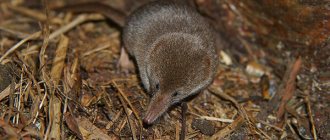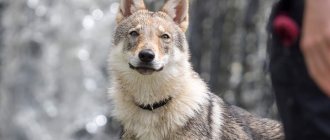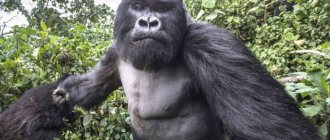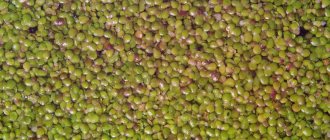- Difference from Lama
When Europeans first set foot on the American continent, a tremendous cultural exchange took place between the inhabitants of two continents previously separated by an ocean. Among the other “miracles” that the white people brought were horses that were previously unknown to the local Indians. But the inhabitants of South America, the legendary Incas and related tribes have long had their own worthy analogue
horses: llamas and alpacas. Alpacas are close relatives of llamas, attractive and peaceful pets, our article is about them.
Description, structure, characteristics
What does an alpaca look like? According to the legend of the Quechua Indians (descendants of the Incas), the alpaca was sent down by the gods themselves, or rather, it was she who accompanied the goddess Pachamama (the ancestor of all people) when she first appeared on Earth. The alpaca was chosen as the goddess's companion for her peaceful disposition and the great benefits she can bring to people. And indeed, in the life of the Incas and other South American Indians, the alpaca occupied (and occupies) the same importance as the horse, cow and pig in the life of our ancestors.
The alpaca is a distant relative of the camel and a close relative of the llama. It is believed that the alpaca is descended from the llama and many even confuse the llama and the alpaca. In fact, there is a difference between them, we will talk about the difference between them a little further in our article.
Alpaca is a calloused animal. What does it mean? The fact that, unlike the herbivores of the “old world”, they do not have hooves, and they walk relying on the phalanges of their toes. Instead of hooves, they have a calloused growth as a foot. And their two-fingered limbs have curved and blunt claws. Thanks to this unusual paw structure, alpacas, unlike sheep and goats, cannot trample pastures with their hooves due to the lack of them.
The weight of an alpaca is on average 60-70 kg, and the height at the withers reaches 1 meter.
The main calling card of this animal is its thick alpaca wool, which is black, brown or white. It is wool that represents the main value of alpacas. In ancient times, robes were made from alpaca wool for the Inca kings, priests and other noble nobles of the Inca Empire, while ordinary Indians were content with clothes made from llama wool. However, even in our time, alpaca wool is of great value, for example, its export is an important part
economy of Peru.
Interesting fact: alpaca wool retains heat six times better than sheep wool, while having a fine and delicate structure.
The upper jaw of alpacas is completely devoid of teeth, but the upper lip is designed like a camel's, it is powerful and forked. The lower jaw has incisors located at an angle. They are the ones who mow down the grass caught by the upper lip.
The alpaca's stomach, unlike other ruminant herbivores, consists of three sections, not four. However, the digestive system of alpacas is very efficient, so a pasture of 1 hectare will be enough to feed a herd of 20-30 individuals.
Another interesting feature of alpacas is their ability to live at high altitudes in thin air. Their lungs are designed in such a way that they can breathe the air there, and their warm wool perfectly protects them from low temperatures.
Natural enemies
The biggest threat to alpacas is posed by large-sized leopards and pumas, which actually live in the usual habitat for these herbivores. Due to the absence of any significant way to defend themselves, even a small concentration of adults will not be able to avoid an attack. In some situations, small predators are not able to cause any harm, since a huge number of spits and blows with the forelimbs quickly scare away ill-wishers.
Leopard is the alpaca's enemy
Difference from Lama
Now let's look at the differences between a llama and an alpaca. Although these animals are close relatives and even interbreed with each other, there are a number of differences between them, so:
Alpaca and llama, alpaca on the left, llama on the right.
Alpaca in captivity
Keeping alpacas in captivity is not difficult; even the Indians were able to tame them. They do not require special conditions, special structures or special feeding systems, because in the wild they are hardened by the harsh climate of the mountains. But alpacas require some care, of course.
Usually they have a small enclosure with a canopy to protect them from rain or snow. A warm room is not required, because unique wool is an excellent thermostat. Their diet does not differ from ordinary herbivorous farm animals. Favorite treat is licking salt.
By nature, animals are very sweet and kind creatures, obedient and unobstinate towards humans. They have an inordinate curiosity that can cause them to get hurt if something catches their attention.
They can be very stubborn in their intentions. Like camels - relatives, alpacas can spit. But they do this only in their own environment, mainly due to the division of food. People are not offended by this habit.
Due to their good nature, communication with alpacas is very useful for educational activities among disabled children and the elderly. One has only to note that sometimes animals show timidity, which is why they can suddenly strike with their legs or head. But in a calm atmosphere they never attack.
The animals are used as pack animals; they are capable of transporting up to 70 kg. But alpacas are kept, mainly, of course, for their wool, which is of great value. Once upon a time, only very rich people wore clothes made from their wool. It is still one of the most expensive.
Breeders spend a lot of money on shipping and breeding alpacas. buy cubs only in special nurseries. Animals are very difficult to breed.
Habitats
Where does alpaca live? Under natural conditions, alpaca lives exclusively in South America, specifically in the highlands of the Andes. Nowadays, they can be found in such South American countries as Peru, Bolivia, Argentina and Chile. Moreover, the largest herds of alpacas are found in the Peruvian Highlands (800 meters above sea level), where they sometimes graze on the edge of the snow.
It is interesting that attempts have been made repeatedly to export alpacas to other countries in Europe and America, but, unfortunately, they did not take root in the natural conditions of other places.
Alpaca habitat and lifestyle
The ancestors of the alpaca, as established through DNA research, were vicuñas from the family of humpless camels, and llamas are their closest relatives. Their habitat is South America, highlands in the Andes.
About 3 million animals live in this territory, in the forests, mountains and on the coast. In other places, the breed does not take root in natural conditions, although animals are exported to many countries of the world for breeding and domestication; more than 60,000 alpacas live in Australia alone, and 10,000 in England. Multiple attempts to acclimatize alpacas in the nature of Europe and Africa ended unsuccessfully.
Human interest in alpacas arose in ancient times, about half a century BC. The ancient Incas began breeding animals for their possession of wool, meat and skin. Even manure was used - it became fuel. The wool of alpacas was called gold by the Incas. Today, for residents of Peru, Bolivia, Ecuador, and Chile, this is an important export product. And once it was the local currency of the Incas.
Alpacas tolerate living in the mountains and harsh climatic conditions thanks to their warm and long wool, which covers them especially tightly on the sides. In terms of quality characteristics, it is seven times superior to sheep.
The alpaca animal in its ancestral territory leads a wild or semi-wild, in captivity, lifestyle. Herds of animals graze in harsh areas of the highlands, almost right next to the snow, where nothing grows except grass. Livestock breeders even sow other plants into local meadows to feed the alpacas.
Under natural conditions, alpacas live in herds . During daylight hours they are active, and at night there is a period of rest. During this time, you need to digest all the food eaten, accumulated during the day.
The animals' natural enemies are mainly pumas and leopards. If small predators attack, alpacas defend themselves with their front legs, striking the enemy and spitting. At the same time, they make sounds notifying their relatives of danger.
Nutrition
What does an alpaca eat? The alpaca is a herbivore, and not particularly fussy about food. Their main source of food is young and fresh grass, which gives them all the necessary nutrients. In addition to grass and free grazing, alpacas can be fed in the same way as horses; they can eat hay, oats, and special food that they are fed with in the cold season, when there is not enough grass.
In addition to food, alpacas also need regular watering.
What do they eat?
Alpaca is a herbivorous ruminant mammal, thanks to which we already know what such species eat. They are unpretentious, able to consume most plant foods in their diet and have a jaw structure convenient for this. The main ingredient in their daily diet is a fairly large amount of fresh grass, which contains all the most important and important nutrients for the body. In addition, their diet is very similar to other ruminants known to everyone - horses, which many have even ridden or at least fed. Apples, hay, oats, special food or even other fruits are what an alpaca will eat without any problems, especially during cold weather, when there is practically no grass left or it is completely absent.
Despite the fact that plant foods contain a huge amount of water, this family still needs constant replenishment of supplies, which is why not every person who decides to get representatives of this species will be able to provide them with adequate nutrition.
They need regular watering, which can take about half an hour or even more per day.
Lifestyle
Alpacas are herd animals that feel safe only in the company of their relatives. The alpaca herd consists of several family groups. The herd is headed by the largest alpha male, followed in the hierarchy by several females close to the leader, and then by the young.
In a herd, it is easier for alpacas to defend themselves from potential enemies, the main of which are dangerous predators: pumas and jaguars. If threatened, the entire herd raises a loud roar, designed to frighten the enemy. Alpacas can use their paws and spit as a means of self-defense. However, spitting, a heritage from camel relatives, is used not only for self-defense, but also for showdowns within the herd between males.
Yes, alpacas are peaceful animals, but there is only one exception, the mating season, when several males lay claim to one female. In this situation, male alpacas, like many other animals, turn into aggressive rivals, but we will dwell on the topic of alpaca reproduction a little further.
Alpacas communicate with each other using special sounds and body movements.
What to knit from alpaca for children
Alpaca is a unique material from which you can knit anything. Alpaca holds elastic and any arans (with royal alpaca you will have to tinker, and the roving will require more density). It has no tendency to unravel or become tight. Stable fabric, warm and soft. Therefore, you can knit any winter clothes for children from alpaca. First of all, things that are in direct contact with the skin are advisable - hats, snoods. The lint does not irritate the skin at all, the thing is warm and wear-resistant.
Hats with ties and ears are beautiful. Many people knit kits for discharge if the birth occurs in the winter. A blanket for the stroller will be very useful.
Types, photos and names
In fact, there are only 2 species of alpacas. Moreover, alpacas themselves were until recently considered one of the types of llamas, but now in the zoological classification they represent a separate species.
Alpaca Suri
This is the rarest variety of alpaca; the wool of this particular species with long and twisted curls has the highest value.
Alpaca Huacaya
Unlike Suri, the population of this alpaca species is much more numerous.
Reproduction
Usually in a herd of alpacas there are harem foundations; the main alpha male alpaca has a harem of females with whom he periodically mates. Sometimes his right to mate, as well as to the role of alpha male, is challenged by other males who are also not averse to becoming alpha and having their own harem. Then hot fights occur between the males. As always, females go to the strongest alpha males.
The pregnancy of a female alpaca lasts 11 months, after which one baby is born; in rare cases, twins can be born. A baby alpaca weighs 6-7 kg at birth and within an hour after its birth it is able to stand on its feet and follow the herd.
How to tame a llama?
The llama needs to be socialized and accustomed to humans only after breastfeeding has ended. In this case, the animal treats the person with curiosity and friendliness. In contrast, llamas that are bottle-fed and tamed to humans too early will be very difficult to handle as adults. If socialized with people too early, adult llamas treat people the same way as their relatives. Early domesticated males often spit, butt and kick people, while females limit themselves to spitting and general unruly behavior.
This condition is called "Lama Berserker Syndrome." The main factors for its occurrence are bottle feeding, too early taming and isolation of the animal from other llamas. As a result, adult llamas do not distinguish humans from their relatives, and try to dominate people. In the most severe cases, males actively bite, kick and attack their owners from behind, attempting to knock the person to the ground.
Castrating males before puberty reduces the chances of berserker syndrome, but neutered males sometimes also exhibit aggressive behavior towards people. Aggressive male llamas with berserk syndrome cannot be retrained, so they are usually euthanized.
However, ordinary llamas without berserker syndrome also often spit at people.
Interesting Facts
- At one time, alpacas suffered greatly from the Spanish conquistadors. Conquering the Inca Empire, they mercilessly destroyed not only Indian temples, which for them were the personification of paganism, but also thoughtlessly destroyed llamas and alpacas. The population of these animals was greatly reduced, so that they were on the verge of extinction. Fortunately, alpacas survived in difficult-to-reach mountainous areas, where the white “civilizers” could not reach.
- Alpaca farming has remained an important activity for Peruvian and Bolivian peasants for centuries.
- High-quality children's clothing is also made from alpaca wool.
Alpaca price
Domesticating animals for wool is a profitable enterprise. Many natural shades, antiseptic properties, resistance to pilling and matting, wear resistance, lack of lanolin - this is an incomplete list of advantages and unique features.
The fur of a young animal is especially valuable and expensive. From one individual, up to 1 kg is cut once every two years. For comparison, an adult animal produces up to 5 kg of wool. Therefore, the cost of the products is considered to be in the high price category: an alpaca scarf made in Italy costs about $400.
Modern technologies make it possible to create unique compositions of materials. A mixture of acrylic fibers and alpaca wool - a high quality fabric. Many people are familiar with alpaca wool blankets and carpets of unsurpassed quality.
A special feature of caring for alpaca coats , scarves, bedspreads, rugs or other items is the inadmissibility of using naphthalene. It is allowed to use only natural anti-mole substances: lavender, tobacco or cedar.
The alpaca has served people for thousands of years, remaining a creature that not only brings benefits in economic life, but also gives people an invaluable connection with primordial nature and history.
Video
Author: Pavel Chaika, editor-in-chief of Poznavaika magazine
When writing the article, I tried to make it as interesting, useful and high-quality as possible. I would be grateful for any feedback and constructive criticism in the form of comments on the article. You can also write your wish/question/suggestion to my email [email protected] or Facebook, with respect, the author.
Author page











